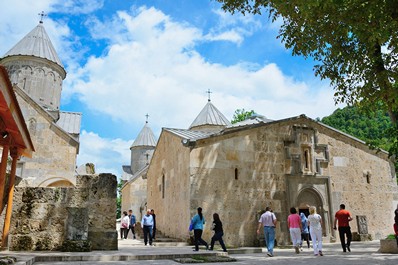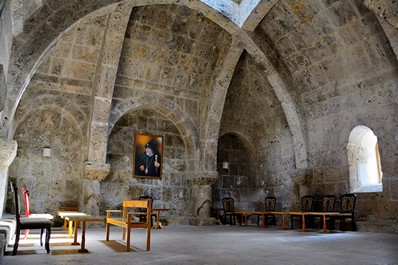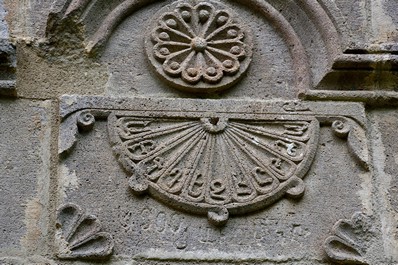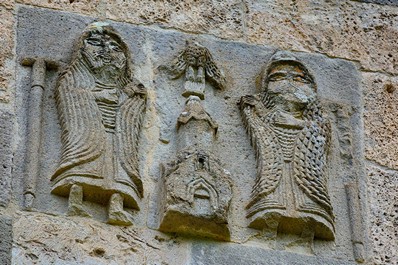
If you travel from Dilizhan to the village of Tekhut through the reserved beech-nut wood the road itself will take you to the monastic complex of the 11 – 13th centuries, Haghartsin. It is the canyon's jewel, one of the most mysterious places in Armenia, buried in the verdure of mountain woods.
The monastery stands in an upper course of the river of the same name (the Agstev's inflow), 18 km from Dilizhan. The territory of the medieval monastery is vast and is occupied by St. Gregory church (11th century), St. Astvatsatsin church (1281), St. Stepanos church (1244), the 13th-century chapel, the tomb of Bagratids (12th century), the refectory (1248) and various premises built in the 12 – 13th centuries.
Haghartsin complex is located high in the woody mountains, where there are eagles and the name of the monastery from Armenian is translated as “games of eagles”. The image of this proud and strong bird can often be seen on the walls of Haghartsin. For instance, sculptures on the eastern façade of the Surp Astvatsatsin (Holy Mother of God) church depict two men in monk clothing and the eagle sitting on the dome of the church.
The most ancient structure of Haghartsin complex is St. Gregory church. It was constructed in the 11th century by monks who escaped prosecutions from Western Armenia which was subject to Byzantium . The rectangular church is rather small. Internal space is cross-shaped. The church is crowned with cone-shaped dome on octahedral drum. In the end of the 12th century a small churchlet from blue basalt with vaulted arches and the room for prayers and burials was added to it.
In 1244 the small churchlet of St. Stepanos, a tiny copy of the main church of St. Gregory was constructed.
The refectory is a rare example of architecture. It was erected by architect Minas in 1248. The room is divided into two square parts covered with the system of crisscrossed arches. Along the wall there pass stone benches; in the western end, near the door is a wide arched doorway for numerous pilgrims.
St. Astvatsatsin (St. Virgin) was originally built in the 11th century; in 1287 it was completely reconstructed. This is the largest structure of the monastery dominating the entire complex The 16-sided church dome is decorated with stucco arches which increase the height of the dome and make it more harmonious and majestic. The Greek-cross building of the church has richly decorated facades.
In the 13th century the monastery became the major centre of spiritual and cultural life of Armenia. Near the refectory there are the ruins of kitchen; near the monastery the remains of several chapels can be seen. Near the southern wall of St. Gregory church there are the ruins of two tombs of Kyurikid dynasty tsars with the inscriptions: "Tsar Smbat" and “It is the tomb of tsar Gagik” (10 – 11th centuries).
Located 2 km from the monastery are the ruins of the medieval village of Haghartsin.







